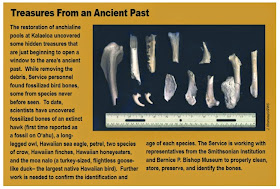Could Ewa's Huge Underground Karst Waterways And Caves Really Exist?
John Bond, Kanehili Cultural Hui
Of course they do and there is lots of evidence of it for anyone who wants to look or listen to Hawaiian oral histories. Hawaiians were not "making it up" when they described the existence of these ancient cave systems.
By all logic and evidence around the world where there has been ancient coral reefs called karst the answer is most definitely YES. In addition Hawaii already has known huge lava tubes that feed large amounts of water into the sea, such as on the Big Island of Hawaii.
The Big Island doesn't have a reef system like the older islands such as Oahu and Maui where there are large reef shelves. In the huge 25 square mile Ewa Plain which is attached to the ancient Waianae volcano the lava tubes became connected through the ancient reef to the shoreline. In some cases the fresh mountain water bubbled up as springs on the land surface or as large underwater outlets that became sea caves and sinkholes called blue holes.
As the Ewa Plain reef extends towards the sea it reaches a depth of approximately 1000 feet, providing ample room for large sea cave systems that have never been seen or explored.
Native Hawaiian oral histories describe huge underground caves running under Oahu connecting different locations. Some caves are fresh waterways, others are salt water portals for sharks and some are walkable large lava tubes. The Big Island, which is the Hawaiian Island chain's newest island without a reef, has some of the largest known caves.
As a recognized historical and cultural expert, Mr. Lee contends that Ewa, Oahu contain a "huge" series of "cave systems" - carved out by underground fresh water - and the caves were used by ancient Hawaiians for their burials long ago. These "cave systems" contain the "iwi" remains of the ancient Hawaiian Chiefs of Oahu, Maui, and Kauai Islands in Hawaii
These Ewa, Oahu "caves" are called "Waipouli Kupuna", and this is where Mr. Lee's family (plus many other Hawaiian families) are buried. They continue to destroy/desecrate the dead, history, culture, AND CONSTITUTION of Hawaii.
Yes, there is very ample evidence around the world that huge karst caves exit. On the Big Island there are also huge lava tube waterways and caves!
The Ewa Plain was a vast coral cave and sinkhole complex used for growing food, overnight shelter, burials and cool storage from the sun. This is how ancient Hawaiians could traverse the ancient Honouliuli ahupua'a trails, which early western explorers saw as barren and hostile. The food, the rest stops and wayside barter shops were there serving the travelers along the way.
The ancient coral reef sinkholes
Not many today know that Pohukaina in downtown Honolulu is actually an Ali'i coral burial cave
This UH SOEST image shows how fresh water erodes channels and pits (caves and sinkholes) into the coral reef creating what the Ewa Plain looked like many thousands of years ago when sea level was much higher than it currently is today.
Modern karst cave explorers inside the Moilili coral cave near the UH Manoa campus
Many people have visited the Moilili caves over the past 100 years. Pumping out the ground water in the 1930's caused a massive cave collapse in the Moilili area, greatly reducing the amount of the cave area that can be explored today.
Inside a cave in Ewa by Roosevelt Avenue in former Barbers Point one can still see and identify Porites lobata coral inside the cave. Other bright colored coral species can still be seen in other karst coral caves in the area. Caves in Ewa contain a great deal of archaeological information, including ancient bird skeletons, but they are routinely bulldozed and filled with concrete grout by land developers today with little if any scientific study.
Coral karst caves can get very, very huge in other parts of the world where vast amounts of tropical rains and rivers carved out vast underground tunnels over the centuries as sea levels dropped.
Huge caves like these very likely exist under the Ewa Plain where the coral shelf is known to go down 1000 feet near the shoreline. This is why in downtown Honolulu, which is also built on an ancient coral reef, large concrete piles being driven will sometimes just suddenly slip and completely disappear into what some only want to call a "void." No one in the construction industry wants to know what is really going on below the ground on Oahu.



















